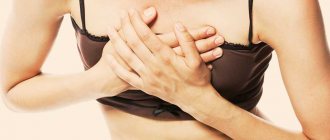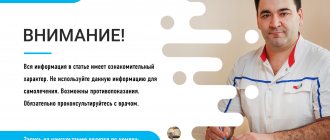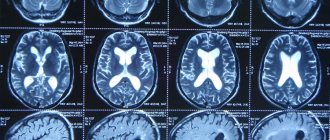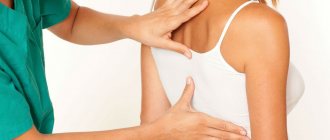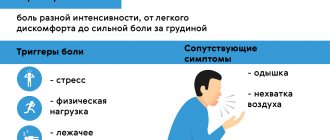Emerging pain in the heart with osteochondrosis can be reflected or true. In the first case, a person experiences unpleasant sensations spreading along the pinched nerve fiber of the roots responsible for the innervation of the intercostal muscles on the left side. In the second case, the situation is much more serious and develops against the background of damage to the radicular or cranial nerves responsible for the innervation of the heart muscle, pacemaker, coronary blood vessels or the formation of the vagus nerve.
More often, pain in the heart is recorded with thoracic osteochondrosis, since the radicular nerves responsible for the innervation of the intercostal muscles and sternum are subject to compression in this type of disease. Also, if the intervertebral disc is damaged in the thoracic region, an inflammatory process may occur that affects the intercostal muscles. The second factor of negative influence is the static tension of the muscular frame of the back, which tries to compensate for the shock-absorbing load that the damaged intervertebral disc cannot cope with.
The pain in the heart that occurs with cervical osteochondrosis is dangerous because it is often associated with damage to the paired cranial nerves. One of these pairs is responsible for the parasympathetic nervous system, which ensures the performance of the myocardial muscle and regulates the work of the pacemaker. The second pair is responsible for the formation of the vagus nerve, which also regulates cardiac activity and controls the volume of arterial blood released into the systemic circulation. If this work is disrupted, a primary form of vascular heart failure may develop.
Damage to the radicular nerves in the lower structures of the cervical spine leads to disruption of the innervation of the coronary vascular bed. This can contribute to the development of coronary heart disease, acute myocardial infarction, etc.
Pain in the heart area that occurs with osteochondrosis is a reason to urgently seek medical help. It is necessary to get an appointment with a vertebrologist or neurologist as soon as possible. Only an experienced doctor will be able to exclude the development of cardiac pathology and prevent negative consequences, such as aortic thrombosis, acute myocardial infarction, coronary artery stenosis, etc.
In Moscow, you can make an initial free appointment with a neurologist at our manual therapy clinic. To do this, just call the administrator and agree on a time convenient for your visit. During the free consultation, the doctor will conduct a full examination, make a preliminary diagnosis, and give individual recommendations for subsequent examination and treatment.
Location (irradiation)
To accurately understand this point, it is worth remembering human anatomy. The heart is located directly behind the sternum and there is an opinion that it should only hurt there. But the heart, like any other organ, receives innervation through the autonomic nervous system. Thus, from the epicenter - the heart - pain spreads through the autonomic nerve plexuses to the area of the left arm, left side of the back, neck, and chest.
Localization of pain during angina pectoris
The occurrence of osteochondrosis is caused by wear and tear of the articular elements. If the thoracic spine is affected, the pain often resembles that of angina pectoris. With osteochondrosis, irradiation can be both to the left and to the right side of the body.
What to do with osteochondrosis and heart pain?
The first thing to do if pain occurs in the heart area due to osteochondrosis of the thoracic or cervical spine is to consult a neurologist. Only an experienced doctor can eliminate the risk of developing cardiovascular pathology. In most cases, cervical osteochondrosis and the heart are connected due to impaired innervation. Therefore, if you have a serious heart disease (coronary disease, atherosclerosis, vascular stenosis, angina pectoris, impaired intracardiac electrical conductivity, arrhythmia, etc.), then you should definitely examine the cervical spine for pinched cranial and radicular nerves . It is this circumstance that provokes most of the pathologies of cardiovascular diseases.
Also, osteochondrosis of the cervical spine can affect the heart with the development of posterior vertebral artery syndrome. This condition is also accompanied by arterial hypertension, dizziness, and frequent headaches.
It is necessary to treat cervical, thoracic osteochondrosis and the heart simultaneously - for this an individual course of manual therapy is being developed. If compression of the radicular nerves is detected, an experienced doctor will conduct several sessions of traction traction of the spinal column. This will stop all the negative consequences of osteochondrosis. Then a planned course of restoration of intervertebral discs will be carried out by enhancing the diffuse nutrition of their cartilage tissue. For these purposes the following can be used:
- reflexology (acupuncture) to activate biologically active points responsible for the regeneration of damaged cartilage tissue, increasing the vitality of the human body;
- osteopathy and massage, improving microcirculation of blood and lymphatic fluid, increasing the elasticity of all soft tissues, promoting the removal of calcium salts;
- therapeutic exercises and kinesiotherapy to restore the process of diffuse nutrition and increase the tone of the muscular frame of the back and collar area;
- physiotherapy, laser treatment, etc.
If you need treatment for osteochondrosis and pain in the heart area, then make an initial free appointment at our manual therapy clinic. An experienced doctor will make an accurate diagnosis and give individual recommendations for the treatment of the identified disease.
Factors that provoke pain
In heart disease, emotional stress plays a key role. Against a background of stress:
- pain increases;
- the number of attacks increases;
- the duration of the pain syndrome increases;
- there is a risk of developing myocardial infarction;
- If medical care is not given in a timely manner, death is possible.
Physical activity also provokes heart pain. The more seriously the disease progresses, the less stress will cause discomfort. In severe stages of the disease, even climbing a few steps is dangerous.
With osteochondrosis, physical activity can also increase pain. The difference is that if a person lies down and takes a comfortable position, the pain will gradually decrease.
Heart pain is often triggered by physical activity
How does osteochondrosis affect the heart?
If there are several factors of how osteochondrosis affects the heart, they are divided into external and internal. An external factor of negative influence is the constant use of non-steroidal anti-inflammatory drugs, which are necessary for pain relief and relief of acute symptoms of this disease. These pharmacological agents act negatively both on the hematopoietic system, triggering the production of defective red blood cells by bone marrow structures, and on the epithelial layer inside the vascular bed. Long-term use of non-steroidal anti-inflammatory drugs increases the aggregation (tendency to stick together) of platelets, which contributes to the formation of blood clots in the coronary blood supply (this is the main cause of the development of acute myocardial infarction). The ability of red blood cells to transport oxygen changes, so the tissues of the heart muscle suffer from constant oxygen starvation.
Internal factors of the negative impact of osteochondrosis on the heart are:
- disruption of the process of innervation of the vascular bed, resulting in its spasm, alternating with prolapse, which entails instability of the blood supply to the myocardium;
- compression of the radicular nerves responsible for the performance of the intercostal muscles - as a result, the breathing process is disrupted and a secondary form of oxygen deficiency may develop, the biochemical parameters of gas exchange change;
- development of posterior vertebral artery syndrome, which leads to a significant deterioration in the blood supply to the medulla oblongata, where the respiratory center is located;
- compression of the cranial nerves responsible for the formation of the vagus nerve and solar plexus - this entails disturbances in heart rhythm, dislocation of the ventricles and atria, disruption of hemodynamics within the heart muscle and in the pulmonary circulation.
Other negative factors include a forced sedentary lifestyle, as the patient tries to avoid increased physical activity in case of severe pain. A secondary change in posture due to static tension in the muscular frame of the back can lead to curvature of the spine and compression of the heart muscle due to deformation of the chest.
Instrumental studies
During periods of acute pain, it is best to seek medical help. In particular, this will certainly help to make a differential diagnosis between osteochondrosis and heart disease.
ECG
When recording a cardiogram, cardiac pathology will be immediately determined. If the ECG is normal, then most likely the cause of the pain is osteochondrosis or neuralgia.
ECG is a mandatory method of examination when chest pain occurs.
Ultrasound
This study can be performed in those patients who are suspected of having an infectious lesion of the heart (carditis of various etiologies). Used only as an additional method.
Radiography
X-ray is indicated for everyone who is suspected of having osteochondrosis. The photographs will show destructive changes in the joints. In case of heart disease, the articular surfaces will be normal.
CT and MRI
Performed when radiography is ineffective. And also to identify a clearer localization of the lesion. Using MRI, you can diagnose both cardiac pathology and osteochondrosis. But a heart attack is an emergency condition that requires urgent drug therapy, and an MRI is a rather lengthy procedure.
Features of chest pain in various pathologies
A description of the discomfort will help distinguish heart pain from neuralgia and osteochondrosis. But the perception of pain is individual, so such a diagram can only provide approximate information.
| Osteochondrosis | Neuralgia | Angina pectoris | |
| Nature of pain | Stitching, aching, cutting, lumbago | Aching, burning, cutting | Stitching or burning |
| Conditions of occurrence | If you are in an uncomfortable position for a long time, sleep in an uncomfortable position, or undergo prolonged or sudden physical activity | With a deep breath, frequent breathing, being in an uncomfortable position, physical activity | During physical or emotional stress, less often in a stuffy room |
| Localization | Behind the sternum on the right or left | Behind the sternum or on the skin on the affected side | Behind the sternum on the left or in the center - in the region of the heart |
| Duration of attack | From a few minutes to several hours | A one-time outbreak of pain when inhaling, until shortness of breath ceases during physical activity, aching - constantly | 5-10 minutes, maximum duration – 30 minutes |
| Terms of termination | Changing body position, stopping activity, therapeutic exercises, massage, deep breathing, anti-inflammatory ointments | Reducing the depth of breathing, changing body position, stopping physical work, ensuring access to oxygen (open a window, go outside) | Stopping physical activity, calming techniques, taking nitroglycerin |
| Seizure frequency | Depends on the patient's physical activity | 1-2 times a month | Extremely variable - from rare attacks once a year to several a day |
| Additional symptoms | Decreased back flexibility, neck crunch, tinnitus, sleep disturbances, decreased cognitive function, back pain | Breathing disorders, shortness of breath, feeling of shortness of breath, dizziness, headaches | Weakness, palpitations, dizziness, fear of death, feeling of lack of air, tinnitus, darkening of the eyes |
Many signs are the same; it is difficult to distinguish pain caused by different causes. Typically, the patient thinks about heart pathology when a heart attack has already occurred. In other cases, angina becomes an incidental finding during examination for other diseases.
Effect of drugs
Most people over 50 have a whole arsenal of medicines at home. And among them there will definitely be remedies for high blood pressure and nitroglycerin.
In case of an acute attack of chest pain, taking nitroglycerin under the tongue is justified. If the pain was of a cardiac nature, it will decrease or disappear completely. After this, you still need to consult a doctor to rule out complications.
If the pain arises from osteochondrosis, then nitroglycerin will not have any effect.
Nitroglycerin will reduce the intensity of pain during an attack of angina pectoris
Clinical case
A 29-year-old patient came to the consultation with complaints of severe pain in the heart.
There is no history of congenital cardiac pathology. A feeling of pressure and burning arose during strength training. The ECG showed no abnormalities; upon palpation, increased pain was noted near the 4-5 vertebrae in the thoracic segment and along the intercostal nerve on the left. X-rays revealed curvature and deformation of the thoracic region, as well as indirect signs of osteochondrosis. He refused an MRI. I took treatment: Diclofenac, Mydocalm. After two weeks of therapy, improvement was noted and the pain stopped. Recommended: reducing stress, a course of massage and physical therapy.
Concomitant pathology
Diseases in which there is a high probability of attacks of pain in the heart:
- Arterial hypertension. Leads to changes in blood vessels, including the vessels that supply the heart muscle.
- Angina. The same pathogen infects the tonsils in the throat and causes the development of endocarditis. Heart damage can be a serious complication of tonsillitis.
- Thrombophlebitis. It can provoke blockage of a vessel of any location, including the heart.
If a diagnosis of angina is made, then the pain occurs precisely because of heart problems. But it may happen that one person develops osteochondrosis and angina. In this case, the person himself can distinguish between 2 types of pain and the source of origin.
Typical and atypical pain sensations
Osteochondrosis of the thoracic region, like any other disease, has a number of characteristic symptoms. List of typical symptoms:
- painful sensations intensify when inhaling, turning the body, raising the arms up;
- the pain begins in one place, and then quickly spreads to the entire chest area. Breathing becomes difficult. The patient is forced to look for a comfortable position. Intercostal neuralgia occurs;
- the muscles are very tense, spasms occur periodically;
- the precursor of intercostal neuralgia is periodic pain, uncomfortable sensations in the back and chest that occur when walking or doing strength exercises;
- The pain intensifies at night, and by morning it may subside completely. It also becomes pronounced during hypothermia.
Osteochondrosis of the thoracic region is characterized by symptoms and sensations that are characteristic of other diseases. Such symptoms are called atypical. These include:
- pain similar to diseases of the cardiovascular system. When taking medications, there is no improvement, and your health may even worsen. Also, no changes are observed on the ECG;
- Women in the acute stage of the disease are characterized by soreness of the mammary glands. This pathology can be excluded by visiting a mammologist;
- Sometimes patients complain of painful sensations similar to pain from gastritis, ulcers, and diseases of the gastrointestinal tract. But, unlike these diseases, with osteochondrosis, increased pain occurs during periods of strength load, and not when eating;
- disorders of the urinary and reproductive system;
- Some patients experience difficulty swallowing reflex, a feeling of “lump in the throat.”
For thoracic osteochondrosis, treatment is required immediately, and self-medication is unacceptable. This can lead to a deterioration in the patient's condition, and subsequently even to disability. Specialists at the Yusupov Hospital can recognize typical and atypical symptoms of the disease. Qualified doctors diagnose thoracic osteochondrosis using modern equipment and treat using the latest effective methods.
Age
Osteochondrosis develops with age. Gradually, a person begins to hurt a joint (one or more) and over time the disease progresses, especially without treatment.
Heart disease, unfortunately, can occur at any age. Even heart attack, angina pectoris and arterial hypertension have recently become younger. They can develop as early as 30 years of age.
Pain that appears repeatedly, is intense, requires control and supervision of a specialist. Therefore, even after coping with an attack, it is necessary to consult a therapist and undergo a full examination.
Treatment
Intense pain due to neuralgia will not allow you to ignore this pathology. It is necessary to urgently seek help from a specialist who will establish a diagnosis and recommend means of combating intercostal neuralgia to avoid the development of more serious complications.
Treatment of intercostal neuralgia is as follows:
- Relief of pain using painkillers (“Gevadal”, “Baralgin”, “Spazmalgon”, “Analgin”, “Brustan”, “Trigan-D”) and NSAIDs (“Celebrex”, “Melox”, “Ketanov”, “ Ketorolac", "Ibuklin", "Dicloberl", "Movalis").
- In case of low effectiveness of NSAIDs and other painkillers, hormonal drugs are needed - Ambene, Diprospan.
- Elimination of pinched nerves and inflammation using novocaine blockades.
- Elimination of the cause that led to the development of neuralgia.
- Reduced physical activity, use of corsets.
- Manual therapy.
- Reflexology.
- Physiotherapy.
- Exercise therapy.
- Massage.
Knowing the differences between pain due to osteochondrosis and heart pathology will allow you to contact the right specialist in time.
How does chondrosis of the thoracic spine occur?
Often, thoracic chondrosis in women and men begins unnoticed; symptoms appear only when pathological changes in the intervertebral discs go far enough. Over time, intervertebral discs change shape, becoming thin and flat. However, compression of nerve endings is possible already in the early stages of the disease. In particularly difficult cases, thoracic chondrosis without proper treatment can lead to disruption of innervation (nerve patency). Also, the disease is often accompanied by the appearance of vertebral hernias, which can only be treated surgically.
Causes and mechanism of development of osteochondrosis
To understand why your back hurts, you need to understand how our spine is structured, how it works, what functions it performs and what factors can lead to its damage.
The human spine consists of 32-34 vertebrae (7 cervical, 12 thoracic, 5 lumbar, 5 sacral, 3-5 coccygeal), between which there is an intervertebral disc consisting of cartilage tissue. In the middle of the intervertebral disc there is the nucleus pulposus - a semi-liquid formation in the form of a “ball”, which performs the function of shock absorption and is surrounded by dense cartilage tissue (fibrous ring). The spinal canal, which contains the spinal cord and the nerves extending from it, runs through the entire spine. This entire structure is surrounded by muscles and ligaments. The main functions of the spine are musculoskeletal, shock-absorbing, and protective.
Imagine the Ostankino TV tower, which is held in a vertical position thanks to a whole system of cables stretched from the base to the top. Likewise, our spine is held in the desired position by a group of stabilizer muscles, which normally evenly distribute the load on the spine and joints. Unlike the Ostankino TV tower, our spine is more complex; it can bend in different directions and even twist, all this is possible due to the presence of an intervertebral disc, muscles and ligaments.
Every day a person makes some monotonous, repetitive movements associated with work or leisure activities. If the same muscles work for a long time, they become overstrained and spasm, while other muscles at this time do not experience any stress at all and atrophy. This leads to a change in the “geometry” of the body, the load on the intervertebral disc is redistributed, spasmed muscles tighten the vertebrae, and nutrition deteriorates. With monotonous hard physical labor, the same processes occur. In addition, the intervertebral disc does not have blood vessels, and its nutrition is provided by the surrounding muscles, and during movement in the intervertebral joint, nutritious synovial fluid enters it.
Cartilage tissue consists of 80-85% water, so the drinking regime is of great importance. During the day, a person should drink at least 2 liters of clean water. If not enough water enters the body, then dehydration (drying out) of the intervertebral disc occurs, the cartilage cracks and collapses.
In my practice, I have long noted that stress, anxiety, and worries often contribute to the occurrence of back pain. Our body perceives any stressful situation as danger. At the same time, the sympathetic part of the nervous system is activated, the adrenal glands “inject” stress hormones into the blood, blood pressure rises, the heartbeat quickens, and muscles tense. In nature, if an animal is frightened of something, it runs or defends itself, accordingly, stress hormones burn and the muscles, after working, relax. Man is a social being; he begins to worry more often and move less, so there is no relaxation. As a result, pain in the spine, headache, motor tics and more occurs.
In the literature you can find different formulations of osteochondrosis, but their essence is the same. Osteochondrosis is a “breakdown” of the motor segment, destruction, degeneration of cartilage tissue. The reason is an incorrect motor stereotype and, as a consequence, a malnutrition of the cartilage.
The progression of osteochondrosis is promoted by: a sedentary lifestyle, heavy physical activity, heavy lifting, obesity, carrying a bag on one shoulder, high-heeled shoes, too soft a mattress for sleeping, frequent hypothermia, bad habits, hereditary predisposition, stressful situations, insufficient drinking regime and other.
